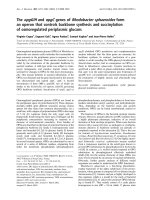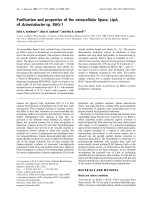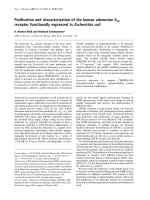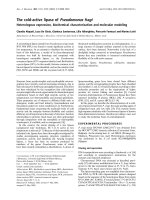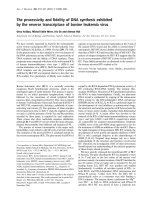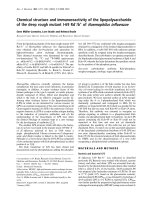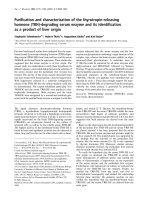Báo cáo y học: "The promise and limitations of population exomics for human evolution studies" doc
Bạn đang xem bản rút gọn của tài liệu. Xem và tải ngay bản đầy đủ của tài liệu tại đây (489.97 KB, 7 trang )
For the past few decades, advances in molecular biology
have continuously refined our understanding of human
evolutionary history. A simple model of expansion and
global migrations from a single ancestral human popu-
lation with adaptation at a few protein polymor phisms
has transformed into a complex scenario involving
introgression among numerous divergent groups,
multiple population-specific bottlenecks, and thousands
of candidate genomic sites of possible evolutionary
importance [1-6]. Although the broad patterns of
demographic trends, geographic population structure,
and adaptation have now been well established [1-4],
emerging genome-scale datasets will enable detailed
inferences about particular populations and genes. Major
ongoing goals include inferring intracontinental patterns
of migration and admixture, reconstructing the history of
human population growth and bottlenecks, and
categorizing whether polymorphisms are selectively
neutral, deleterious, or adaptive (Box 1). Until recently,
such questions could be addressed only with the limited
statistical power and precision afforded by single
nucleotide polymorphism (SNP) arrays or small sets of
sequence data. However, exome sequencing has the
potential to address many of these questions.
Exome sequencing is a new and powerful technique in
which genomic DNA that binds to a predefined target of
known exons is sequenced using next-generation
technology, in order to capture the protein-coding
Abstract
Exome sequencing is poised to yield substantial
insights into human genetic variation and evolutionary
history, but there are signicant challenges to
overcome before this becomes a reality.
© 2010 BioMed Central Ltd
The promise and limitations of population exomics
for human evolution studies
Jacob A Tennessen
1
, Timothy D O’Connor
1
, Michael J Bamshad
1,2
and Joshua M Akey
1
*
O P IN I ON
*Correspondence:
1
Department of Genome Sciences, University of Washington, 3720 15th Ave NE,
Box 355065, Seattle, WA 98195-5065, USA
Full list of author information is available at the end of the article
Box 1. Goals and methods of population genetics
Extant patterns of human genetic variation provide information
about our demographic and evolutionary history. The goals of
population genetics are to infer past events from DNA sequence
variation and identify and quantify how evolutionary processes,
such as natural selection, population structure, migration, genetic
drift, and changes in population size, have shaped human
genomic diversity. To this end, numerous population genetics
statistics have been developed for analyzing genetic variation.
A brief synopsis of population genetic statistics well suited to
exome data is as follows.
π: The expected number of dierences between two sequences
randomly selected from the same locus in a population is
represented as π. If π is calculated per base pair, data on both
variable and invariant sites, and therefore sequence data rather than
SNP array data, are required. Numerous evolutionary inferences
rely on π. Its overall magnitude reects the mutation rate and
eective size of a population. Unusually high or low π at a locus
can be a signature of natural selection. Most genes in most human
populations have per base π values between 10
-4
and 10
-3
[13].
Site frequency spectra: A site frequency spectrum represents
the relative numbers of variants occurring at all frequencies in
a population. The proportion of rare variants as compared with
common variants can be used to infer the rate and timing of
population growth. Unique spectra for certain genes or certain
site classes are thought to reect variation in the strength and
form of natural selection. For example, a selective sweep may
eliminate all variation, and all new variants arising after the sweep
will be rare initially, resulting in a skewed spectrum with a relative
dearth of common variants. Tajima’s D is a summary statistic of
the site frequency spectrum, with negative values indicating a
relative excess of rare variants, positive values indicating a relative
excess of common variants, and values near zero indicating
mutation-drift equilibrium. Site frequency spectra are most
accurately inferred with large amounts of unbiased sequence
from numerous individuals, as provided by exomics.
Nonsynonymous/synonymous neutrality tests: Natural
selection is expected to act more strongly on nonsynonymous
sites than synonymous sites, and there are numerous statistical
tests that compare these site classes in order to study selection.
Exomes represent the exact portion of the genome where such
tests are applicable. For example, the McDonald-Kreitman test
[34] compares the ratio of polymorphism at these two site classes
with the ratio of interspecies divergence at these two site classes.
Under constant purifying selection these two ratios should be
similar, so a discrepancy is evidence for adaptive evolution.
Tennessen et al. Genome Biology 2011, 12:127
/>© 2011 BioMed Central Ltd
portion of the genome [7]. e magnitude and cost-
effectiveness of exome datasets vastly overshadow many
other methods for studying polymorphism that have
recently been popular, such as SNP arrays or single locus
resequencing studies. Here, we discuss the application of
exome data to human population genetics. We argue that
exomes will allow many important and detailed analyses
that are not possible with SNP arrays because of
ascertainment biases. Moreover, although whole-genome
sequencing in large population samples is clearly on the
horizon, exomes are the most cost effective and practical
way of obtaining sufficiently high coverage to rigorously
characterize the spectrum of rare variation. However, the
absence of noncoding data does limit the application of
exomes in nontrivial ways and can lead to misleading
inferences if research is not carefully conducted. us,
we are cautiously optimistic that exomes will address
many remaining questions about human evolution, if
incompletely.
Exome sequencing – an unbiased measure of
polymorphism
Exome sequencing provides an unbiased and complete
perspective of coding genetic variation to a degree that
has never before been possible. In many respects,
‘exomics’ combines the most favorable aspects of the
other available molecular methods (Figure 1). For
example, SNP arrays provide a picture of genome-wide
polymorphism in many individuals [3,8,9], but they
necessarily suffer from ascertainment biases favoring
previously identified SNPs that are common in the
populations (primarily of European ancestry) used for
variant discovery [10,11]. Gene sequencing eliminates
this bias and also provides data on invariant sites for
measuring overall polymorphism, π, which underlies
numerous population genetic statistics (Box 1). However,
studies that examine individual genes illustrate only a
small portion of the functional genome. Genome
resequencing therefore provides the most complete view
of polymorphism [12], but cost, computational
complexity, and data storage issues make it difficult at
present to sequence thousands of individuals or more at
high coverage, which is required for studies of rare
variants. us, most large-scale genome sequencing so
far has used relatively low coverage, biasing the dataset in
favor of common variants and confounding demographic
and other evolutionary inferences that require an
unbiased sample. By contrast, exomics provides a
practical way to generate an unbiased picture of variation
within a large number of samples at functionally
important regions of the genome. By assessing all of the
variants within the targeted region, including rare and
novel polymorphisms, exome sequencing enables
accurate inferences of the site frequency spectrum
(Box 1, Figure 2). Similarly, because all protein-coding
genes are examined, the relative numbers of very specific
types of polymorphism (for example, mutations to each
amino acid residue), within narrowly defined site-
frequency classes (for example, singletons versus
doubletons), can also be estimated accurately.
It is important to note that the ideal filtering strategy
used to generate an exome dataset differs slightly
between population genetics and phenotype association
studies. In association analyses, the goal is usually to
maximize the number of putatively real variants, any of
which could be causal for the trait in question, and to
Figure 1. The contributions of dierent data types to population genetic inferences. Exomes, SNP arrays, and genomes are likely to capture
dierent combinations of these four basic site types: common variants, rare variants, invariant sites, and noncoding sites. Each site type oers
unique information relevant to analyses of demography and natural selection. Rare variants and invariant sites captured in exomes are important
for numerous evolutionary questions, from estimating the eective population size to detecting positive selective sweeps, and they may be
missed by other methods. However, phenotypically causal noncoding variants and truly neutral regions far from genes and free from the eects of
selection are absent from exomes.
Demographic inference
True neutral sites
Ancient events, major trends
Effective size, mutation rate
Recent events, subtle trends
Natural selection inference
True neutral controls, some causal sites
Balancing selection, geographic divergence
Selective sweeps, very conserved regions
Recovery from sweep, deleterious variants
Site
Noncoding
Common
Invariant
Rare
Large exome sample
Large SNP sample
Small genome sample
Noncoding
Exon
Variant (rare or common)
}
}
Tennessen et al. Genome Biology 2011, 12:127
/>ignore invariant sites. However, for endeavors such as
resolution of population structure, it is preferable to
discard sites with missing data in a substantial proportion
of samples in order to minimize clustering of individuals
based on ‘missingness’, defined here as the proportion
and identities of genotypes with missing data, and
knowledge of invariant sites is essential. As exome
sequencing becomes routine and optimized, it will be
important to maintain some flexibility in filtering options
based on particular research goals.
Detecting natural selection from exome data
One of the most promising applications for exome data is
the study of natural selection in humans [13]. Inferring
patterns of natural selection on genes is a powerful
approach for gauging the functional impact of
polymorphisms. Although a nontrivial amount of non-
coding DNA is functional, it is clear that exons contain a
substantial proportion of the genome’s phenotypically
relevant sites, subject to strong selective pressures [14].
Natural selection is also easier to study using exons, as
many existing statistical tests for estimating selection,
such as those based on the ratios of nonsynonymous to
synonymous sites, are appropriate only for coding
sequence (Box 1). However, most of the signature of a
selective event can lie in noncoding regions, even if the
target of selection is in an exon. Exome data provide
substantial power to detect regions of low polymorphism
or high linkage disequilibrium only if exon density in the
region is sufficiently high. Even then, estimating the
precise length of the region affected by selection is not
possible without full sequence data, although sequencing
the flanking noncoding areas after identifying an
interesting region is always an option.
Positive selection, the fixation of new favorable alleles,
is an important evolutionary phenomenon that has
proven difficult to thoroughly characterize. Numerous
studies have identified genomic regions displaying
extreme values in statistical tests of selective neutrality,
but the overlap among these lists of candidate regions is
often poor, suggesting a high proportion of false positives
[4]. In addition, it is often unclear whether outlier SNPs
are themselves the targets of selection or merely linked to
the true targets [4,15]. Analysis of exome sequences
promises to enhance power for resolving these issues. A
typical signature of a positive selective sweep includes
low π and an excess of rare variants, which can most
directly be identified with sequence data. Assuming that
the real causal variant is in an exon, it can be pinpointed
with high precision. Owing to their rich information
content, even a small sample of exomes can show
differences between selected and neutral regions and
allow adaptive substitutions to be identified [13]. For
example, the causal nonsynonymous polymorphism in
SLC24A5, a gene that influences skin pigmentation, is a
clear outlier with respect to both interpopulation
divergence and patterns of polymorphism in flanking
exons, such that its adaptive significance is apparent in a
sample of as few as ten exomes [13,16].
Figure 2. The inuence of sample size in detecting recent
population expansions. (a) Demographic model used in the
simulations. Times of demographic events (in units of thousands of
years, kyr) and population sizes are indicated. (b) The site frequency
spectrum for sample sizes of 50 and 2,000 chromosomes. (c) Average
value of Tajima’s D based on 10
4
simulation replicates as a function
of sample size (number of chromosomes). The lines denote values
of Tajima’s D from the demographic model in (a) (black line) and a
constant sized population (green line). This simulation illustrates the
power of large sample sizes for inferring recent demographic events.
All information in (b,c) is based on simulating 10 kb of sequence.
50
10,000
600
49
10,000
1,000,000
2
Time (kyr)
(a)
0.0
0.2
0.4
0.6
1 2 3 4 5 6 7 8 9
Minor allele count
Proportion
n = 2,000
n = 50
(b)
0
-2.0
-1.5
-1.0
-0.5
0.0
Number of chromosomes
Tajima’s D
(c)
10 >10
1,000 2,000 3,000 4,000 5,000 6,000
Tennessen et al. Genome Biology 2011, 12:127
/>Whether human populations actually harbor a large
proportion of adaptive coding variants flanked by regions
of low π or skewed site frequency spectra depends on
where and how selection usually acts in humans, which is
still unresolved. If selection acts primarily on non-coding
regions [17] or on standing genetic variation, such that
dramatic polymorphism-reducing selective sweeps do
not occur [18-20], exomes will have less of an advantage
over other methods such as SNP arrays or full genomes
for studying positive selection. So far, the clearest
example of positive selection inferred from exome data is
the hypoxia response gene EPAS1, which has evolved
rapidly in high-altitude Tibetan populations [21]. e
strongest candidate SNP at EPAS1 is in an intron that
happened to be included, and the primary evidence for
positive selection is high divergence between populations
rather than low polymorphism. e fact that the gene
was still identified highlights the versatility of exomes,
but SNP-based or noncoding-inclusive approaches might
have had similar, if not greater, power to detect selection
in this case.
Balancing selection, the maintenance of multiple
favorable variants, can also be studied with exome data.
Under the classic model of balancing selection, two or
more alleles are maintained at intermediate frequency in
a population. Most of these cases in humans have
probably already been identified because the variants in
question would be common, although flanking sequence
data can help strengthen or refute the case for balancing
selection on a particular SNP, as in the case of the prion
protein gene PRNP, in which a widely publicized claim of
cannibalism-associated balancing selection [22] was
shown to be an artifact of ascertainment bias [23]. Under
other forms of balancing selection, one allele might be
very rare and therefore as yet undiscovered. For example,
under fluctuating selection [24], a currently deleterious,
and therefore rare, allele may have been advantageous in
the past and could be again in the future. Similarly, the
equilibrium allele frequencies in the case of over-
dominance, or heterozygote advantage, are proportional
to the relative selective disadvantages of each homozygote
genotype [25]; thus, if one homozygote is quite
deleterious (for example, lethal), whereas the other is
only slightly less deleterious than the heterozygote, a
highly skewed allele frequency will be maintained by
balancing selection. It is unknown whether these more
complex forms of balancing selection have an important
role in the patterns of human genetic diversity, and
exomes are ideal for this line of inquiry because their
cost-effectiveness allows even rare alleles to be observed.
Purifying selection, the elimination of deleterious
mutations, is by far the most common type of selection.
erefore, it is the most relevant to human health
because, for the vast majority of functionally relevant
polymorphisms in a genome, the derived variant will be
deleterious. Distinguishing harmful variants from benign
variants is a central goal of disease genetics, and
population genetic studies to identify purifying selection
are directly relevant to this goal. With a large sample of
exomes, it is possible to estimate the probability of
deleteriousness for a nonsynonymous variant given its
frequency. Assuming that only benign variants ever reach
high frequency, the ratio of nonsynonymous to synony-
mous sites at high frequency can be used to calculate the
relative excess of nonsynonymous sites, which are
presumed to be deleterious, at lower frequencies [26].
Given the enormous number of variants in an exome
dataset, this approach can be tailored to highly specific
site classes, based on biochemical properties of the
encoded residue or patterns of conservation across
species, rather than simply comparing all nonsynony-
mous and all synonymous polymorphisms. Furthermore,
genes with very few nonsynonymous variants overall that
do not show evidence of a selective sweep are likely to be
under strong purifying selection, so there is an enhanced
probability that subsequently discovered rare nonsynony-
mous variants are deleterious. Such highly conserved
genes can be identified only with data on invariant sites
from many individuals, which exomes provide.
Population structure and demography
Natural populations are not static and often have
complicated demographic histories, including changes in
population size and non-random mating leading to
geographic structure. Rare variants and unascertained
common variants identified from exome sequencing will
be a powerful resource for inferences of demographic
history. So far, resequencing efforts of smaller subsets of
the human genome have already yielded a comprehensive
portrait of historical changes in population size, and the
relationship between geographically diverse populations,
migrations, and admixture [2,27-29]. For example, both
African and non-African populations have experienced
bottlenecks followed by an exponential increase in
population size, although the magnitude of these events
has been greater for non-African populations [2,28,29].
Exome sequence data will facilitate more precise
estimates of important parameters governing human
history, such as the mode and timing of population
expansions.
Of particular interest, exome data are well poised to
enable new insights into recent demographic events.
Because exome sequencing is currently more cost-
efficient than whole-genome sequencing, it is possible to
study patterns of variation in very large samples. To
explore this idea in more detail, we performed a simple
coalescent simulation of a population that experienced a
bottleneck of moderate intensity 50,000 years ago and a
Tennessen et al. Genome Biology 2011, 12:127
/>more recent population expansion 2,000 years ago
(Figure 2a). e goal here is not to perfectly recapitulate
human demography, but to demonstrate how exome
sequence data might facilitate inferences of recent events.
From this model, we explored how the site frequency
spectrum varies as a function of sample size. As shown in
Figure 2b, there is a dramatic shift towards rare alleles,
particularly singletons (sites where the minor allele is
only observed once in the sample), for larger sample
sizes. To quantify this affect more rigorously, we
calculated Tajima’s D statistic (Box 1), which is expected
to be negative in cases of an excess of rare variation
relative to what is expected in constant sized populations.
For small sample sizes (Figure 2c), the recent population
expansion is ‘invisible’ and Tajima’s D is close to zero,
which is the expected value in populations of constant
size. However, as sample size increases, Tajima’s D
becomes sharply negative, revealing the recent explosive
population growth. Intuitively, these results make sense
because the larger sample size provides sufficient
numbers of mutations to reveal the recent underlying
genealogical structure. Interestingly, in populations of
constant size, Tajima’s D is not influenced by sample size
and stochastically varies close to zero (Figure 2c). us,
because exome sequencing can be performed in large
samples, these simple simulations suggest that there is
considerable promise in more detailed and quantitative
estimates of recent human demographic history.
Moreover, as described above, because exome data do
not suffer from the same ascertainment bias inherent in
SNP arrays or small-sample datasets, it will possible to
explore more nuanced questions related to population
structure. For example, an interesting hypothesis to test
is whether rare variants have signatures of structure that
are different from those derived from common variants.
Intuitively, as rare variants are predominantly derived
from mutations in the recent past, they may be
particularly useful in assessing intracontinental, or
perhaps even finer-scale, population structure, even if
allele frequency differences at common variants are
negligible. Similarly, exome data will also be a powerful
resource for understanding how the process and
dynamics of admixture manifest themselves in patterns
of variation [30] across the genome. At the individual
level, exome data may allow reconstruction of the mosaic
structure of ancestry blocks (stretches of the genome
inherited intact from a parental population [31]), which
will provide mechanistic insights into the admixture
process and the differences in demographic history of the
parental populations [30]. As with SNP array datasets
and other genomically incomplete data, haplotypes in
unsequenced (noncoding) regions must be inferred from
the existing data, with a precision that depends on the
density of sequenced (coding) genotypes.
An important general caveat of exome data in
understanding human demographic history is that
purifying selection acting on deleterious variants will
complicate inferences of population parameters, such as
effective population sizes, and the site frequency
spectrum [32]. A simple strategy to attenuate these
concerns is to focus analyses on classes of sites that are
expected to be less strongly influenced by purifying
selection (such as synonymous sites and targeted
introns). However, new methodological approaches that
jointly estimate demographic parameters and selection
are clearly more desirable and important to develop [33].
Challenges and caveats for population exomics
Although exome datasets remove many of the biases and
limitations that have plagued previous population genetic
datasets, they can still be misinterpreted if not analyzed
appropriately. One potential challenge is presented by
cryptic paralogs. Copy number variation is prevalent and
remains poorly characterized in humans. Reads from
exons that are absent from the capture target, perhaps
because they only occur in some individuals, can map to
paralogous exons on the capture target, falsely inflating
apparent π in these exons. In many cases, these exons can
be removed from analysis by filtering on violations of
Hardy-Weinberg equilibrium.
Another concern is missing data. It is common to
remove invariant sites from exome files in order to reduce
them to a manageable size. However, estimates of π
require differentiating between truly invariant sites and
sites that might be variable but were not sequenced at
high coverage in many individuals. For some analyses, it
is sufficient to estimate ‘missingness’ at invariant sites
rather than measure it directly, but doing so carries the
important caveat that regions of low π could merely be
regions of low coverage.
A third challenge is the difficulty of merging datasets.
As yet, there is no one accepted definition of the exome.
Rather, there are numerous capture targets with different
combinations of exons. Even if two targets share the same
exon, coverage may be better in one of the targets for a
variety of technical reasons. us, when sequences from
multiple targets are combined into a single dataset,
missing data at some sites will be high and highly
correlated with the target used. If different populations
were sequenced with different targets, analyses of
population structure are then confounded. e use of
multiple sequencing platforms could potentially cause a
similar pattern. Furthermore, multi-sample calling
methods for assigning genotypes are more likely to call a
variant if it is also seen in other samples, so calling
genotypes in batches can cause artifacts if these batches
are then merged with each other or with single-sample
called genotypes. ese effects can be minimized by
Tennessen et al. Genome Biology 2011, 12:127
/>excluding sites with a high proportion of missingness,
but the best approach is to use the same target and
sequencing platform on all samples, and to call genotypes
on all samples either all together or else individually.
A fourth caveat is that even with a low overall error
rate, the sheer size of the exome means that false
positives are inevitable. ese can be minimized with
strict filters on depth and quality, at the cost of discarding
some real variants (for example, increasing the false
negative rate). e stringency of filtering depends on the
research goal. For most population genetic analyses, a
subset of the exome with consistently high-quality data is
preferred to a complete exome with a large number of
false positives.
A further caveat, perhaps self-evident, is that exomes
provide no information about noncoding regions,
including many functionally important noncoding sites.
Exomics researchers should be careful not to assume that
all evolutionarily relevant variation has been captured by
exomes. Indeed, some of the most well-documented
targets of selection, such as the regulatory region of the
lactase gene LCT, may leave little detectable signature in
exomes [13].
Finally, exomes present the difficulty of a deluge of
data. Storing and accessing large exome files is a
computational challenge, although exomes are easier to
work with than whole genomes. In addition, interpreting
the functional consequences of one particular variant
among hundreds of thousands is a daunting task. Given
that even strict filtering does not eliminate error, it is
recommend that sites or regions showing unusual
polymorphism patterns be validated with Sanger
sequencing before drawing any definitive conclusions
about these loci.
Concluding remarks
Exome sequencing represents an important milestone in
genomics, and provides a powerful tool for population
geneticists that will facilitate estimates of numerous
evolutionary parameters with much greater precision
than was previously possible. Until large full-genome
datasets in all populations of interest are feasible, exomes
will represent the best available resource for inferring
patterns of human demography and natural selection in
an unbiased and comprehensive manner.
Acknowledgements
This work was supported by a research grant (1R01GM076036) from the NIH
to JMA and the NHLBIGo Exome sequencing Project (HL-102923) to JMA and
MJB.
Author details
1
Department of Genome Sciences, University of Washington, 3720 15th Ave
NE, Box 355065, Seattle, WA 98195-5065, USA.
2
Department of Pediatrics,
University of Washington, 1959 NE Pacic St, Box 356320, Seattle, WA 98195-
6320, USA
Published: 14 September 2011
References
1. Garrigan D, Hammer MF: Reconstructing human origins in the genomic
era. Nat Rev Genet 2006, 7:669-680.
2. Schaner SF, Foo C, Gabriel S, Reich D, Daly MJ, Altshuler D: Calibrating a
coalescent simulation of human genome sequence variation. Genome Res
2005, 15:1576-1583.
3. Li JZ, Absher DM, Tang H, Southwick AM, Casto AM: Worldwide human
relationships inferred from genome-wide patterns of variation. Science
2008, 319:1100-1104.
4. Akey JM: Constructing genomic maps of positive selection in humans:
where do we go from here? Genome Res 2009, 19:711-722.
5. Green RE, Krause J, Briggs AW, Maricic T, Stenzel U, Kircher M, Patterson N, Li
H, Zhai W, Fritz MH, Hansen NF, Durand EY, Malaspinas AS, Jensen JD,
Marques-Bonet T, Alkan C, Prüfer K, Meyer M, Burbano HA, Good JM, Schultz
R, Aximu-Petri A, Butthof A, Höber B, Höner B, Siegemund M, Weihmann A,
Nusbaum C, Lander ES, Russ C, et al.: A draft sequence of the Neandertal
genome. Science 2010, 328:710-722.
6. Reich D, Green RE, Kircher M, Krause J, Patterson N, Durand EY, Viola B, Briggs
AW, Stenzel U, Johnson PL, Maricic T, Good JM, Marques-Bonet T, Alkan C, Fu
Q, Mallick S, Li H, Meyer M, Eichler EE, Stoneking M, Richards M, Talamo S,
Shunkov MV, Derevianko AP, Hublin JJ, Kelso J, Slatkin M, Pääbo S: Genetic
history of an archaic hominin group from Denisova Cave in Siberia. Nature
2010, 468:1053-1060.
7. Ng SB, Turner EH, Robertson PD, Flygare SD, Bigham AW, Lee C, Shaer T,
Wong M, Bhattacharjee A, Eichler EE, Bamshad M, Nickerson DA, Shendure J:
Targeted capture and massively parallel sequencing of 12 human exomes.
Nature 2009, 461:272-276.
8. The International HapMap Consortium: A haplotype map of the human
genome. Nature 2005, 437:1299-1320.
9. The International HapMap Consortium: A second generation human
haplotype map of over 3.1 million SNPs. Nature 2007, 449:851-861.
10. Akey JM, Zhang K, Xiong M, Jin L: The eect of single nucleotide
polymorphism identication strategies on estimates of linkage
disequilibrium. Mol Biol Evol 2003, 20:232-242.
11. Clark AG, Hubisz MJ, Bustamante CD, Williamson SH, Nielsen R:
Ascertainment bias in studies of human genome-wide polymorphism.
Genome Res 2005, 15:1496-1502.
12. The 1000 Genomes Project Consortium: A map of human genome variation
from population-scale sequencing. Nature 2010, 467:1061-1073.
13. Tennessen JA, Madeoy J, Akey JM: Signatures of positive selection apparent
in a small sample of human exomes. Genome Res 2010, 20:1327-1334.
14. The Encode Project Consortium: Identication and analysis of functional
elements in 1% of the human genome by the ENCODE pilot project.
Nature 2007, 447:799-816.
15. Grossman SR, Shylakhter I, Karlsson EK, Byrne EH, Morales S, Frieden G,
Hostetter E, Angelino E, Garber M, Zuk O, Lander ES, Schaner SF, Sabeti PC: A
composite of multiple signals distinguishes causal variants in regions of
positive selection. Science 2010, 327:883-886.
16. Lamason RL, Mohideen MA, Mest JR, Wong AC, Norton HL, Aros MC, Jurynec
MJ, Mao X, Humphreville VR, Humbert JE, Sinha S, Moore JL, Jagadeeswaran P,
Zhao W, Ning G, Makalowska I, McKeigue PM, O’Donnell D, Kittles R, Parra EJ,
Mangini NJ, Grunwald DJ, Shriver MD, Caneld VA, Cheng KC: SLC24A5, a
putative cation exchanger, aects pigmentation in zebrash and humans.
Science 2005, 310:1782-1786.
17. Carroll SB: Endless forms: the evolution of gene regulation and
morphological diversity. Cell 2000, 101:577-580.
18. Pritchard JK, Pickrell JK, Coop G: The genetics of human adaptation: hard
sweeps, soft sweeps, and polygenic adaptation. Curr Biol 2010,
20:R208-R215.
19. Hernandez RD, Kelley JL, Elyashiv E, Melton SC, Auton A, McVean G, 1000
Genomes Project, Sella G, Przeworski M: Classic selective sweeps were rare
in recent human evolution. Science 2011, 331:920-924.
20. Tennessen JA, Akey JM: Parallel adaptive divergence among geographically
diverse human populations. PLoS Genet 2011, 7:e1002127.
21. Yi X, Liang Y, Huerta-Sanchez E, Jin X, Cuo ZX, Pool JE, Xu X, Jiang H,
Vinckenbosch N, Korneliussen TS, Zheng H, Liu T, He W, Li K, Luo R, Nie X, Wu
H, Zhao M, Cao H, Zou J, Shan Y, Li S, Yang Q, Asan, Ni P, Tian G, Xu J, Liu X,
Jiang T, Wu R, et al.: Sequencing of 50 human exomes reveals adaptation to
high altitude. Science 2010, 329:75-78.
Tennessen et al. Genome Biology 2011, 12:127
/>22. Soldevila M, Andrés AM, Ramírez-Soriano A, Marquès-Bonet T, Calafell F,
Navarro A, Bertranpetit J: The prion protein gene in humans revisited:
lessons from a worldwide resequencing study. Genome Res 2006,
16:231-239.
23. Kreitman M, Di Rienzo A: Balancing claims for balancing selection. Trends
Genet 2004, 20:300-304.
24. Bell G: Fluctuating selection: the perpetual renewal of adaptation in
variable environments. Philos Trans R Soc Lond B Biol Sci 2010, 365:87-97.
25. Hedrick PW: Genetics of Populations. 3rd Edition. Sudbury, MA: Jones and
Bartlett, 2005:140.
26. Li Y, Vinckenbosch N, Tian G, Huerta-Sanchez E, Jiang T, Jiang H, Albrechtsen
A, Andersen G, Cao H, Korneliussen T, Grarup N, Guo Y, Hellman I, Jin X, Li Q,
Liu J, Liu X, Sparsø T, Tang M, Wu H, Wu R, Yu C, Zheng H, Astrup A, Bolund L,
Holmkvist J, Jørgensen T, Kristiansen K, Schmitz O, Schwartz TW, et al.:
Resequencing of 200 human exomes identies an excess of low-
frequency non-synonymous coding variants. Nat Genet 2010, 42:969-972.
27. Akey JM, Eberle MA, Rieder MJ, Carlson CS, Shriver MD, Nickerson DA,
Kruglyak L: Population history and natural selection shape patterns of
genetic variation in 132 genes. PLoS Biol 2004, 2:e286.
28. Voight BF, Adams AM, Frisse LA, Qian Y, Hudson RR, Di Rienzo A: Interrogating
multiple aspects of variation in a full resequencing data set to infer
human population size changes. Proc Natl Acad Sci USA 2005,
102:18508-18513.
29. Coventry A, Bull-Otterson LM, Liu X, Clark AG, Maxwell TJ, Crosby J, Hixson JE,
Rea TJ, Muzny DM, Lewis LR, Wheeler DA, Sabo A, Lusk C, Weiss KG, Akbar H,
Cree A, Hawes AC, Newsham I, Varghese RT, Villasana D, Gross S, Joshi V,
Santibanez J, Morgan M, Chang K, Iv WH, Templeton AR, Boerwinkle E, Gibbs
R, Sing CF: Deep resequencing reveals excess rare recent variants
consistent with explosive population growth. Nat Commun 2010, 1:131.
30. Pfa CL, Parra EJ, Bonilla C, Hiester K, McKeigue PM, Kamboh MI, Hutchinson
RG, Ferrell RE, Boerwinkle E, Shriver MD: Population structure in admixed
populations: eect of admixture dynamics on the pattern of linkage
disequilibrium. Am J Hum Genet 2001, 68:198-207.
31. Bryc K, Auton A, Nelson MR, Oksenberg JR, Hauser SL, Williams S, Froment A,
Bodo JM, Wambebe C, Tishko SA, Bustamante CD: Genome-wide patterns
of population structure and admixture in West Africans and African
Americans. Proc Natl Acad Sci U S A 2010, 107:786-791.
32. McVicker G, Gordon D, Davis C, Green P: Widespread genomic signatures of
natural selection in hominid evolution. PLoS Genet 2009, 5:e1000471.
33. Williamson SH, Hernandez R, Fledel-Alon A, Zhu L, Nielsen R, Bustamante CD:
Simultaneous inference of selection and population growth from patterns
of variation in the human genome. Proc Natl Acad Sci U S A 2005,
102:7882-7887.
34. McDonald JH, Kreitman M: Adaptive protein evolution at the Adh locus in
Drosophila. Nature 1991, 351:652-654.
Tennessen et al. Genome Biology 2011, 12:127
/>doi:10.1186/gb-2011-12-9-127
Cite this article as: Tennessen JA, et al.: The promise and limitations of
population exomics for human evolution studies. Genome Biology 2011,
12:127.



